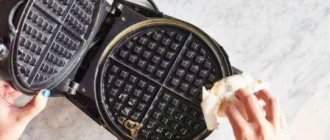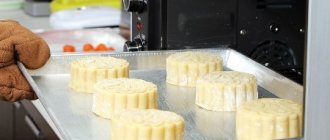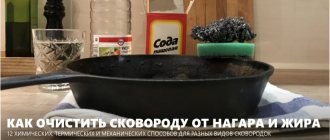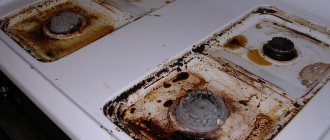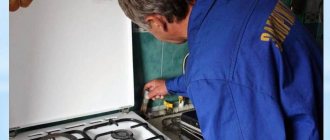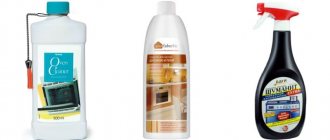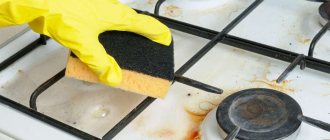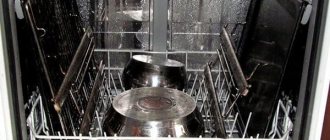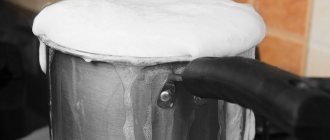Depending on the material the pan is made of, there are different methods for cleaning up burnt-on grease. Cast iron pans hold up very well to harsh chemicals and traditional methods, while aluminum pans can only be washed with a very specific method. Teflon pans are easily damaged by mechanical action, so chemical methods are preferable. For cleaning, laundry soap, ammonia, peroxide, office glue, activated carbon, soda, salt, soap suds and professional products are used.
Before you begin, the goal should be to remove any burnt-on fat from the pan without damaging its surface. Depending on the material from which the product is made, different methods are relevant.
Soda and salt
Baking soda and salt are used as abrasives that can physically break down even very thick layers of burnt fat.
Soda and salt
To do this, pour some hot water into a frying pan and add a moderate amount of dry baking soda or salt to create a saline solution. Using a stiff sponge, rub the powder evenly into the fat until the sharp edges of the crystals begin to break it up. Periodically, dirty salt and soda are washed off from the pan with washed pieces of fat, after which the processing begins again.
Baking soda itself is very active. Chemically, in the presence of hot water, it is able to break down fat, dissolving it into a liquid. The effect is enhanced by adding vinegar to baking soda - a violent reaction can greatly dissolve fat and wash away even goose crust from a frying pan or a greasy plate from the hood and ventilation ducts.
Citric acid or lemon juice
Citric acid quickly washes away fat or softens a large greasy stain. To better remove carbon deposits, it is better to preheat the oven to 40 degrees. When using lemon juice, squeeze one fruit into a cup of water. If citric acid is used, then you should dissolve 1 teaspoon of powder in a glass of water .
The product is used as follows:
- apply to the walls inside the oven;
- leave for 40 minutes to dissolve contaminants;
- After this time, wipe the oven with water.
Lemon juice, in addition to fat, helps get rid of the burnt smell. You can also soften the carbon deposits by heating the product with citric acid. To do this, fill a heatproof bowl halfway with water, add a small amount of detergent and finely chopped lemon.
Place the container in the oven and heat to 150 degrees. During boiling, the steam softens old fat, which makes it easier to clean later. It is necessary to preheat the oven for 30 minutes , then cool it. When the walls become warm, wipe them with a sponge.
For burnt stains, you can prepare a stronger solution. To do this, a bag of citric acid is mixed with 1 teaspoon of cleaning powder and 1 tbsp. spoon of detergent. The mixture should be as thick as liquid sour cream. It should be applied inside the device and left for 20 minutes to dissolve the carbon deposits. When the mixture dries, it must be moistened with water. After treatment, stains can be quickly cleaned with a solution of dishwashing liquid.
Laundry soap
Dishwashing soap is a universal remedy for removing any dirt, including grease burned on the bottom of pots and pans. It’s unlikely to cope with a very thick layer of soap, but you can deal with a fresh one.
laundry soap
Rub a piece of laundry soap on a medium grater in a deep clean bowl and add a little hot water. The mixture is stirred until a homogeneous thick mass is formed, which turns into soot. It is better to leave the pan in this form for several hours for the soap to work properly. When the paste is completely dry and crusty, rinse it with hot water along with some oxidized grease.
Laundry soap is low-active, so it will not be possible to remove soot right away. This procedure will have to be repeated several times.
Possible contamination
Housewives love non-stick cookware and use it every day. But over time, the food in your favorite frying pan begins to burn. Not many people know what to do in such cases, and often immediately buy a new product.
What can cause soot to appear:
- Incorrect operation;
- Failure to follow the rules for washing non-stick coatings;
- Using sharp objects to mix food in containers.
A layer of fat and soot is deposited on both the inside and outside of the frying pan. The danger of soot is as follows: when heated, it begins to release carcinogens that negatively affect health.
What other problems may arise with your favorite frying pan:
- Over time, nonstick cookware becomes coated with a layer of sticky grease. It is especially surprising when this happens to good housewives, because they thoroughly wash the dishes after each use. Unfortunately, it is almost impossible to completely remove grease from a frying pan, so it needs to be properly cleaned periodically.
- Rust appears on the non-stick coating. If you do not thoroughly dry the product after washing, rust stains will form on it, which will subsequently be difficult to remove.
- Remnants of burnt food. The pan should be washed thoroughly after each use. If there are burnt foods on the coating, they should be completely removed without damaging the non-stick layer.
Liquid products
In the household appliances departments of hardware stores, special liquids are sold that are designed to dissolve even the hardest fat deposits. The components of the liquid actively react with fat, dissolving it before our eyes. These products are much more effective at descaling a frying pan than traditional methods, but their cost is very high.
Carbon remover
Such measures are recommended to be applied either to branded dishes, or if traditional methods do not hit the scale. A clean Teflon frying pan greased with it is preferable due to the harmfulness of the ceramic coating.
Sprays
Special products are sold not only in the form of liquids in bottles and cans, but also in the form of sprays.
Spray for removing soot and grease
The grease cleaner is sold in a special container with a convenient spray nozzle, which allows you to economically and evenly apply the liquid to the surface of the container. This can make it much more economical to mop up grease from the pan with a spray.
Prevention
To avoid having to deal with such a labor-intensive cleaning process again, you should:
- Every time after cooking, wipe the inner walls, baking sheets and doors with a light soapy solution;
- Prepare dishes in a special sleeve, so that greasy splashes will not fall on the walls;
- You can choose an oven with a self-cleaning function.
A few words about the “self-cleaning” oven. Yes, this option is available in many modern models. But many housewives, when using it, noticed that as a result the oven simply steamed.
The stains don't disappear, they just can be treated with steam. The only advantage of this procedure is some softening (acidification) of old stains, which makes cleaning the oven easier. You can't expect any better results.
We hope you are convinced that it is possible to cope even with stubborn and old dirt using both household chemicals and folk remedies. It is much easier and more convenient for yourself to prevent this from happening or to wipe off plaque as soon as it appears.
Gels and creams
The most concentrated professional products are produced in the form of gels and creams, which are designed for quick and effective cleaning of pans from fatty deposits of any complexity.
Gel for removing fat deposits.
They can be applied outside or inside the surface of the frying pan with gloved hands or a special brush. Fat, which loves to stick to metal, will literally dissolve before your eyes, leaving residue that needs to be washed off with plain water.
Method 3. “Heavy Artillery”
And now, let's look at a more radical way to clean the oven from old grease and fumes using special products from Amway, Faberlic or Bagi Shumanit spray.
- Gel for cleaning ovens. Briefly about popular oven cleaning products:
- Amway “Oven Cleaner” - odorless, effective, economical to use, sold together with a brush for distributing the product, but has a high price;
- Faberlic “Oven and Stove Cleaner” - costs less, has good reviews, but is not used economically;
- Bagi “Shumanit” is effective, easy to use, as it is sprayed from a spray, sold in any store, relatively affordable, but has a pungent odor.
What we need:
- Water;
- Rubber gloves (required!);
- Sponge, rag, brush for treating hard-to-reach places;
- ...Fresh air from an open window (especially if you use Schumanite and other products with a strong odor).
- Remove everything unnecessary from the oven: remove and set aside the rack, baking sheets and all other oven contents.
- Lubricate all surfaces of the chamber and the door with gel: this is very convenient to do with a brush or a toothbrush (for example, a toothbrush). Before you start processing, open the window and put on gloves!
- Let the product “work”: leave the oven for 15-30 minutes, depending on the degree of contamination.
- Clean the oven from burning and grease: after this “soaking”, old grease and burnt-on food stains will be washed off quickly enough.
- Remove any remaining product: When you have cleaned all surfaces of dirt, thoroughly rinse off any remaining gel. A spray of water will help clean the camera in hard-to-reach places.
- Put the pans and rack back in place: well, that's it. All that remains is to wipe the outside of the door.
Foam cleaning
The foam contains surfactants designed to remove stubborn stains from household pots.
Washing a pot with foam
Foam from regular dishwasher detergents will deal with this quickly, as will the special products described above. The foam usually has a quick but short-lasting effect, allowing you to clean the surface of a non-stick pan of fresh grease.
Household chemicals
Today, the choice of household chemicals intended for ovens cannot but rejoice.
Our stores now have really working powders, gels and pastes that are ready to deal with any fat.
We advise you to definitely look at the composition, because it should not contain acid that could damage the inner coating of the oven.
We recommend paying attention to such proven products as Synergetic, Cilit Bang Anti-fat, Schumanit, Efsto (+ from Faberlic have also proven themselves well).
Activated carbon
Activated carbon is another folk remedy that can cleanse the inside and outside of fresh and old clots of fat.
Activated carbon
The pan is soaked in water, a large amount of active carbon is applied to the oil surface, after which the pan is left for a long period of time.
It is advisable to leave the pan with activated carbon overnight.
Method 1. Proven
This folk recipe is good because you can find all the ingredients in your kitchen; the method is suitable for cleaning a moderately dirty oven.
- Baking soda;
- Vinegar;
- Water;
- Latex gloves;
- Damp cloth;
- Plastic or silicone spatula;
- Spray.
- Remove the rack from the oven: Remove and set aside the rack, as well as the baking sheets, pizza stone, oven thermometer, and anything else that is inside.
- Make a baking soda paste: In a small bowl, mix 1/2 cup baking soda with a few tablespoons of water. Add water until the mixture becomes paste-like. In our case, 3 tablespoons of water were used.
- Treat the oven with the resulting product: apply the mixture to all internal surfaces of the oven, avoiding the heating elements. Don't forget to wear gloves to avoid getting your hands dirty and apply the paste to the most difficult to reach areas. In particularly dirty areas, the mixture may turn brown from soot and grease and form lumps - such areas should be coated especially thickly.
- Leave the baking soda in the oven overnight: Leave the baking soda mixture in the oven overnight, or for at least 12 hours.
- Wash the racks and baking sheets: While the oven is soaking, clean the racks and baking sheets. This can also be done by pre-soaking in a bath of dishwashing detergent and then mechanically cleaning with baking soda.
Cleaning with office glue
Stationary adhesive can significantly improve the properties of laundry soap.
Stationary glue
Based on it, a special solution is prepared, in which you need to prepare a frying pan with a greasy residue or a frying pan with burnt jam. A piece of laundry soap is rubbed into a container that can fit a frying pan. Several tubes of writing glue were also added there. The mixture is stirred until a homogeneous mass is formed, into which the frying pan is placed.
Carefully! When preparing dishes, the hood must be running; glue vapors can be toxic to the human body.
After a while, remove the pan, add plenty of water and a metal scraper to remove any remaining fat, and dry thoroughly.
In addition to glue, you can use ammonia and hydrogen peroxide.
Method 4. Effective
This method will make it much easier for you to get rid of complex contaminants due to ammonia vapor.
- 5 bottles of ammonia (200 ml);
- Soda (if necessary);
- Small bowl for ammonia;
- Large bowl for water;
- Water (about 1 l);
- Latex gloves;
- Sponge and rag;
- ...Fresh air from an open window.
- Remove pans from oven: Remove and set pans aside, but leave racks on.
- Preheat the oven to 180 degrees.
- Pour the water and ammonia into their respective bowls: While the oven is heating, pour all 5 bottles of ammonia into a small bowl and the water into a large bowl. Don't forget to open the windows.
- Turn off the oven and place both bowls in it: in the preheated oven, place a bowl of water on the bottom of the oven, and place a bowl of ammonia a little higher (on the shelf).
- Leave the oven to cool: this process will take approximately 30-40 minutes. But, if the stains are very old, then it is better to leave the bowl of ammonia overnight.
- Clean the oven and grate: when the walls of the chamber have cooled, use a damp cloth, sponge and baking soda to remove grease and carbon from all surfaces and the grate.
- Wipe the oven clean: remove any remaining residue from the ammonia solution and dirt.
- Place the pans and rack back in place and wipe down the outside of the oven door.
How to clean an aluminum pan
Aluminum reacts well to grease buildup and is very difficult to clean. Regular lubricants will not work on aluminum pans, so you should choose an aluminum cleaner, such as Aluminum Pots and Pans, or a household cleaner.
Aluminum pallet
You can also remove any grease from the aluminum using a blower to ensure the pan heats evenly on all sides.
How to clean a cast iron frying pan from years of carbon deposits
A cast iron skillet can be cleaned using all the methods described above.
Cast-iron pan
Do not use metal scrapers to forcefully remove grease as this may damage the cast iron saturation guard. The oil layer is restored by heating a frying pan with a large amount of sunflower oil until a large amount of soot forms.
How to clean a ceramic frying pan
Ceramic cookware has the ability to repel grease from each other, which significantly speeds up cleaning.
Ceramic frying pans
Teflon models have these properties, which prevent grease from accumulating. Such frying pans are very sensitive to mechanical cleaning and sudden temperature changes, so cleaning a Teflon frying pan will be difficult for beginners.
